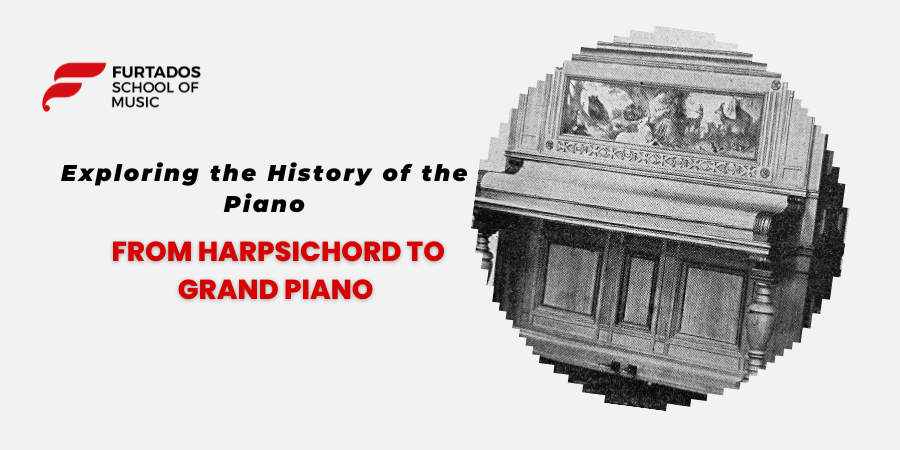The piano, with its melodious tones and expressive capabilities, is a beloved instrument that has enchanted music enthusiasts for centuries. As you embark on your journey to learn piano through piano classes and piano lessons at Furtados School of Music, it’s fascinating to delve into the instrument’s rich history. From its humble beginnings as a harpsichord-like contraption to the grand pianos we know today, the evolution of the piano is a captivating tale of innovation and craftsmanship.
The Harpsichord: Precursor to the Piano
Before the piano’s invention, the harpsichord reigned supreme as the primary keyboard instrument in Europe during the Baroque period (1600-1750). The harpsichord produced sound by plucking strings with quills, resulting in a limited dynamic range and an inability to control the volume. This limitation left musicians yearning for an instrument that could produce both soft and loud sounds, leading to the birth of the piano.
Invention of the Piano
The credit for inventing the piano goes to Bartolomeo Cristofori, an Italian instrument maker, who crafted the first known piano in the early 18th century. Cristofori’s invention addressed the harpsichord’s limitations by introducing a mechanism that allowed the player to control the volume and expression. Here are some key innovations that paved the way for the modern piano:
- Hammer Action: Cristofori’s piano featured hammers that struck the strings, enabling varying levels of loudness depending on how forcefully the keys were pressed. This innovation was a significant departure from the harpsichord’s quill-plucking mechanism.
- Escapement Mechanism: Cristofori incorporated an escapement mechanism that allowed the hammer to fall away from the string after striking it, permitting immediate repetition of the note. This action is the foundation of modern piano keyboards.
- Dynamic Range: The piano, derived from the Italian word “pianoforte,” meaning soft and loud, earned its name due to its ability to produce a wide dynamic range, from whisper-soft to thunderously loud.
The Evolution Continues: Fortepiano and Square Pianos
The pianos built by Cristofori and his early successors were known as fortepianos. These instruments were relatively compact and had a more delicate sound compared to today’s grand pianos. Over time, piano builders made several key advancements, including:
- String Tension: Increased string tension allowed for more substantial sound projection and a brighter tone.
- Wooden Frames: Early pianos had wooden frames, which were later replaced by iron frames, providing greater stability and enabling the construction of larger grand pianos.
- Range Expansion: Pianos started with a limited number of keys but gradually expanded to the 88 keys we are familiar with today.
Additionally, square pianos, also known as “square grands,” gained popularity during the 18th and 19th centuries. These pianos had a square-shaped design and were more affordable than grand pianos. They found their way into many homes, making music accessible to a broader audience.
The Emergence of the Grand Piano
The 19th century marked a significant turning point in the piano’s history with the development of the grand piano. Some key innovations that contributed to the grand piano’s dominance include:
- Cast Iron Frames: The use of cast iron frames provided structural stability, allowing for larger and more resonant soundboards.
- Cross-Stringing: Cross-stringing, where the strings cross over one another, improved string tension and enhanced the piano’s tonal quality.
- Innovations in Soundboard Design: Advancements in soundboard design allowed for better sound projection and tonal clarity.
- Artistic Cabinet Design: Grand pianos became not only musical instruments but also pieces of art, with ornate cabinet designs and intricate details.
The grand piano’s superior sound quality, coupled with its aesthetic appeal, established it as the instrument of choice for pianists and composers alike.
Modern Pianos: A Blend of Tradition and Technology
Today, the piano continues to evolve, incorporating modern technology without compromising its rich heritage. Digital pianos offer portability, versatility, and features such as built-in metronomes and recording capabilities. While digital pianos have their merits, traditional acoustic grand pianos remain cherished for their authenticity and timeless appeal.
As you embark on your quest to learn piano at Furtados School of Music, you’ll have the opportunity to explore and appreciate the remarkable journey of the piano, from its harpsichord-like origins to the grand pianos that grace concert halls worldwide. Our experienced instructors are here to guide you through this musical odyssey, helping you develop your skills and understanding of this magnificent instrument.
In conclusion, the history of the piano is a testament to human ingenuity and a passion for creating beautiful music. Whether you aspire to play on a classic grand piano or explore the possibilities of a digital instrument, the piano’s enduring legacy continues to inspire generations of musicians, including those who embark on their piano classes and piano lessons at Furtados School of Music.
